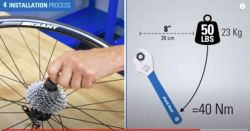szekel wrote: @ marshals and could you show a simple example based on these formulas? And what are the constants 0.5 and 0.25?
For example, tighten an M10 bolt with a length of l = 100 mm using a torque of 100 Nm. Let us assume that the bolt presses directly with its head against the friction surface, the dimensions of the friction surface for a standard M10 bolt with a key 17: Dp = 17 mm, dp = 11.2 mm. We take the coefficient of friction 0.1 and the Young's modulus 210 GPa.
Such a screw has a pitch P = 1.5 mm and an average thread diameter ds = 9.026 mm. The tangent of the helix angle is:
tg? = P / (? * ds) = 0.0529
hence
? = 3.025 °
Apparent friction angle tangent:
tg ? '= u / cos30 °
30 °, it follows that it is half the angle of the metric thread, such a surface is affected by the frictional force in the thread.
tg ? '= 0.1155
? '= 6.589 °
Having these two slightly abstract parameters, we transform the formula into the moments of friction so as to determine the tension force for the bolt. It's a bit hard to write formulas here so I'll give you the result right away:
F = 68,041 N
A standard M10 bolt has a cross-sectional area of S = 52.266 mm?. E = 210 GPa, while the length l = 100 mm, let's assume that this is only the length of the tensile part. From Hook's law:
?l = (l * F) / (S * E)
?l = 0.62 mm
So if:
? = ?l * 360 ° / P
then for ?l = 0.62 mm:
? = 148.8 °
So you only need to turn the screw almost 150 degrees. Except that it is 150 ° of pure stretch, i.e. when the slack is removed, the dirt is out, etc. Also note that we stretch 100 mm of the bolt by only 0.6 mm, and such a small stretch causes a force of over 68 kN, which is almost 7 tons . In fact, this force is so great that even a 10.9 bolt would not hold out, I should have taken the M12 as an example, but I did not want to count again.
The constant 0.5 means half, because the torque is the force multiplied by the radius on which the force acts, and the radius is half the diameter. In this case, the diameter is ds, and half of ds is 0.5 ds. However, 0.25 is half of a half, which results from the calculation of the mean radius of the washer, which is half the distance between the outer diameter Dp and the inner dp, and the radius is half the diameter .
Oh, maybe I made a mistake, I learned it a long time ago, and if there is any constructor here, let him check me.



